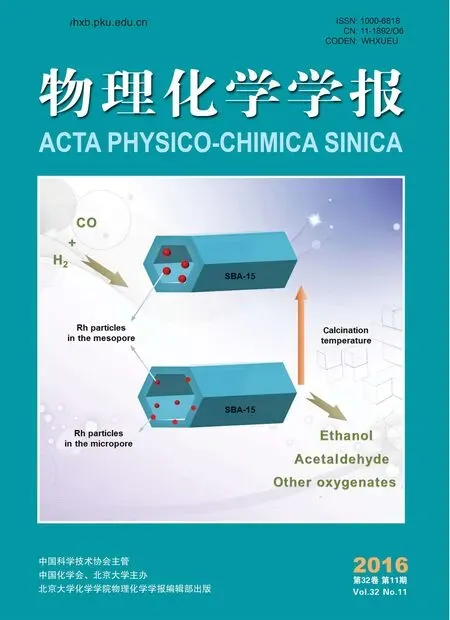埃洛石纳米管稳定的Pickering高内相乳液模板制备大孔聚合泡沫吸附分离三氟氯氰菊酯
陈 香 潘建明 闫永胜
(江苏大学化学化工学院,江苏镇江212013)
埃洛石纳米管稳定的Pickering高内相乳液模板制备大孔聚合泡沫吸附分离三氟氯氰菊酯
陈 香 潘建明*闫永胜
(江苏大学化学化工学院,江苏镇江212013)
利用天然粘土埃洛石纳米管和少量非离子表面活性剂吐温80为乳化剂构建了水包油(O/W)型Pickering高内相乳液(HIPEs),并以其为模板制备了大孔聚合泡沫(MPFs)。MPFs具有开口的大孔结构、丰富的内部交联孔道和亲水的表面,且在水中呈悬浮状态,这些特点均有利于吸附水体系中的菊酯类农药。结合静态吸附实验研究了MPFs吸附三氟氯氰菊酯的平衡与动力学行为。结果表明,准一级动力学方程与Langmuir等温方程分别较好地拟合了吸附动力学与平衡数据(相关性系数(R2)>0.99),证明了吸附过程是一个单分子层的化学吸附过程。298 K时MPFs对三氟氯氰菊酯的吸附平衡时间和饱和吸附容量分别为240 min和23.98 μmol·g-1,且吸附容量随着温度与三氟氯氰菊酯初始浓度的升高而逐渐增大。研究证明了水中呈悬浮状态的MPFs是理想和稳定的吸附剂,可有效去除水溶液中疏水性有机污染物。
吸附;大孔聚合泡沫;埃洛石纳米管;动力学;Pickering高内相乳液
Key Words:Adsorption;Macroporous polymer foam;Halloysite nanotube;Kinetics;Pickering high internal phase emulsion
1 Introduction
In agricultural situations,pyrethroids are widely used for the control of a wide range of pests because of their insecticidal effectiveness and low mammalian toxicity1.For the most commonly used pyrethroids,most of them are used in open environment,so their residues have become one of the major carcinogenic pollution risks to the drinking water supplies2.Despite their extremely low water solubility,recent studies showed widespread occurrence of pyrethroids in downstream surface waters bodies via surface runoff3.Moreover,pesticides at high concentration are tending to inhibit the microbial biomass during the biological treatment process.Thus,it is necessary to reduce the pesticide concentration in the wastewater before transfering into biological treatment plants4.Adsorption processes using various of adsorbents have shown many ecological and technological advantages5,6.Previous studies have shown that hydrophobic organic pollutants have a low aqueous solubility and tend to be effectively adsorbed by suspended particles7.As a consequence,low-cost and suspended adsorbents have become promising for drinking water and wastewater treatment,especially regarding pyrethroids.
Porous materials with highly permeable and connected pores are good candidates for adsorbents.For instance,Liu et al.8prepared highly porous chitosan by a unidirectional freeze-drying method,and evaluated their high-capacity adsorption for a range of metal ions.Dong′s group9synthesized porous carbon adsorbent by chemical modification of hydrothermally synthesized carbon nanosphere,and the as-prepared adsorbent was expected to possess excellent performance for the adsorption of bulky dyes from aqueous solution.A novel porous composite ofα-Fe2O3/Fe3O4/C was prepared via a calcining process at 600°C,and their highly efficient phosphate removal from water and wastewater was also reported10.
Recently,high internal phase emulsion(HIPEs)has been considered as the effective approach to the synthesis of porous material.HIPEs,also called highly concentrated emulsions,are defined by possessing a volume fraction of the disperse phase that exceeds 0.74,which can be used as templates for the preparation of macroporous polymer foams(MPFs)via the polymerization of the external(continuous)emulsion phase11,12.However,conventional MPFs synthesized from surfactant stabilized water-in-oil (W/O)or oil-in-water(O/W)HIPEs have poor mechanical properties and low permeabilities13.Bismarck et al.14employed particle and small amounts of surfactant as template to stabilize W/O HIPEs(Pickering HIPEs),and the obtained porous materials after polymerization possessed well-defined open-cell structure and excellent mechanical properties.Then many work about the W/O Pickering HIPEs have been considered to prepare hydrophobic porous foams which tended to float on the surface of aqueous solutions15,16,whereas comparatively few reports on the O/W Pickering HIPEs and hydrophilic porous materials which dispersed or suspended in the aqueous solutions.This challenge could be addressed by employing the particles just with the right hydrophilicity that can be used as stabilizers of O/W Pickering HIPEs.Zhang17and Ngai18et al.applied commercial titania(TiO2) and poly(nisopropylacrylamide)-co-(methacrylic acid)microgel as stabilizer to get O/W HIPEs,respectively,and then obtained the corresponding hydrophilic macroporous polymers.
Halloysite nanotubes(HNTs)are two-layered aluminosilicate clay mineral,and possess hollow nanotubular structure and hydrophilic surface.Furthermore,HNTs are more widely available and much cheaper than other nanoparticles such as carbon nanotubes and titanate nanotubes19.Lehle et al.20demonstrated that non-spherical colloids at free interfaces capillary interactions appear to be dominant,and non-spherical particles were benefit to form a stable emulsion.Herein,HNTs and small amounts of nonionic surfactant were adopted as O/W Pickering stabilizers of HIPEs,and the stabilizing behavior of the HIPEs was further clarified.Then λ-cyhalothrin21,as one of the typical pyrethroids compounds,was used to investigate the adsorption properties of the prepared MPFs.
2 Experimental
2.1Materials
HNTs were collected from Zhengzhou Jinyangguang Chinaware Co.Ltd.(Henan,China).Prior to use,raw HNTs were milled and sieved followed by being oven-dried at 373 K for 24 h.Then the HNTs were purified in the mixture of concentrated sulfuric and nitric acids(1:3 by volume)at 80°C with constant stirring for 6.0 h.Afterwards,the samples were washed with distilled water and rinsed for several times in order to reach neutral pH.Finally,the HNTs were dried in vacuum at 60°C for further use.Ammonium persulphate(APS),paraffin liquid,and acetone were supplied by Sinopharm Chemical Reagent Co.,Ltd. (Shanghai,China).Acrylamide(AM),N,N′-methylene bisacrylamide(MBAM)and Tween 85 were purchased from Aladdin reagent CO.,Ltd(Shanghai,China).λ-cyhalothrin was supplied by Jiangsu Huangma Agrochemicals Co.,Ltd.(Jiangsu,China). APS,AM,MBAM,and λ-cyhalothrin used in the experiment are all analytically pure,and the paraffin liquid,Tween 85 are chemically pure.Water was freshly deionized.
2.2Instruments
Infrared spectra(4000-400 cm-1)were recorded on a Nicolet NEXUS-470 FTIR apparatus(USA).The morphology of MPFs was observed by scanning electron microscopy(SEM,S-4800). The image of the HNTs was obtained by transmission electron microscope(TEM,JEOL IEM-200CX).The optical micrographs of Pickering HIPEs were collected by a DMM-330C optical microscope equipped with a high performance digital camera (CAIKON,China).Thermo gravimetric analyzer(TGA)and differential scanning calorimetry(DSC)of samples were per-formed for powder samples(about 10 mg)using a Diamond thermo gravimetric/differential thermal analysis(TG/DTA)instruments(Perkin-Elmer,USA)under a nitrogen atmosphere up to 800°C with a heating rate of 5.0°C·min-1.The static water contact angle was measured by using a KSV CM200 contact angle instrument(Finland).
2.3Synthesis of MPFs
0.08 g of activated HNTs and 0.04 g of surfactant Tween 85 were initially dispersed into 4.0 mL of deionized water under the condition of ultrasound bath for 30 min.Then 1.420 g of the monomer AM,0.309 g of the crosslinker MBAM and 0.02 g of initiator APS were also dissolved in the above HNTs dispersion, the mixture was stirred for 1.0 h.Then 16 mLof oil phase paraffin liquid was added into the above mixture drop by drop under rapid stirring.After 3.0 h,a stable Pickering HIPEs was then transferred to a 25 mL thick-walled glass tube,and polymerized in a 50°C oven for 24 h.The obtained materials were removed from the tube, dried in a vacuum at 50°C for 24 h,and extracted in Soxhlet apparatus with acetone to remove any impurities.Finally,the resulting products MPFs 1 were dried to constant weight in a vacuum at 50°C.In order to study the effect of Tween 85,MPFs 2 were prepared according to the above process except using 0.04 g Tween 85.
2.4Batch mode binding experiments
All adsorption isotherm and kinetics tests were conducted by a batch equilibrium procedure.In the isotherm test,10 mg of MPFs were added into 10 mL of λ-cyhalothrin solution in ethanol and deionized water(5:5,V/V)at different concentrations(10,30, 50,80,and 100 mg·L-1).The adsorption was carried out in thermostatically controlled water bath at 25 or 30°C which was shaken at a speed of 100 r·min-1.After incubating for 12 h,MPFs were collected by centrifugation and the solutions were immediately filtered through a millipore cellulose nitrate membrane (pore size was 0.45 mm)to remove suspended particles.The amount of λ-cyhalothrin in the filtrate was determined by a UV-Vis spectrophotometer at 278 nm(UV-2450,Shimadzu,Japan).
In the kinetic test,10 mL of λ-cyhalothrin solution in ethanol and deionized water(5:5,V/V)at a concentration of 100 mg·L-1was considered as testing solution,and then the precess followed a similar procedure at 25°C except that samples were taken in a different time such as 0.5,1.0,2.0,4.0,and 6.0 h.
All tests were conducted in triple and an average value was used.The λ-cyhalothrin adsorption on the MPFs at given time was calculated according to Eq.(1).

where Qtis the captured λ-cyhalothrin at time t(mg·g-1).C0is the initial λ-cyhalothrin in water(mg·L-1),and Ctis the λ-cyhalothrin in filtrate at time t(mg·L-1).V is the solution volume(L),and W is the adsorbent weight(g).The equilibrium adsorption amount (Qe)and equilibrium concentration of λ-cyhalothrin in the isotherm tests were calculated with the same method.
3 Results and discussion
3.1Design of O/W Pickering HIPEs and MPFs
As part of our continuous efforts to produce different types of adsorbents by Pickering Emulsion,our aim was to design a macroporous and dispersed material to effectively remove λ-cyhalothrin.Fabrication of a stable Pickering HIPEs was the key to obtain MPFs,then non-ionic surfactant Tween 85 and HNTs were employed as the excellent dispersing agent and emulsifier for Pickering HIPEs with the internal phase volume fraction of 80%. In our work,the illustrations for preparing Pickering O/W HIPEs were shown in Fig.1(a,b).According to our previous study,HNTs had tube-like shape and hydrophilic surface due to the presence of a great deal of hydroxyl groups,which are proper to prepare W/ O Pickering HIPEs without adjusting the wettability22.Moreover, the introduction of HNTs could increase the mechanical property of composites resulted from Pickering HIPEs template23.Lehle et al.20suggested that for non-spherical colloids at free interfaces capillary interaction appear to be dominant,W/O Pickering HIPEs stablized by HNTs are super-stable due to the nearly irreversible adsorption of the non-spherical particles at the oil/water interface because of their high energy of attachment.As shown in Fig.1a, when external water phase was incorporated with the internal oil phase without rapid stirring,only the phase-separated system was formed,and most of the hydrophilic HNTs exhibited weakly flocculated states and accumulated at the bottom of testing tube. After rapid stirring,pink Pickering HIPEs due to the existence of HNTs nanoparticles was formed,which was very stable and hadno obvious change in 1.0 month(Fig.1b).In order to estimate the mean droplet sizes,a drop of the resulting Pickering HIPEs was placed on a microscope slide and viewed using an optical microscope.As shown in Fig.1c,it could be observed Pickering HIPEs were spherical and polydisperse,and the mean sizes of the emulsions was μm.Fig.2 showed the digital photographs of a drop of Pickering HIPEs dispersing in toluene(a)and water(b).This method was used to test type of the emulsions.The drops of Pickering HIPEs collapsed immediately in water,whereas the drops floated on the surface of toluene.These facts indicated that the formed Pickering HIPEs were the O/W emulsions.
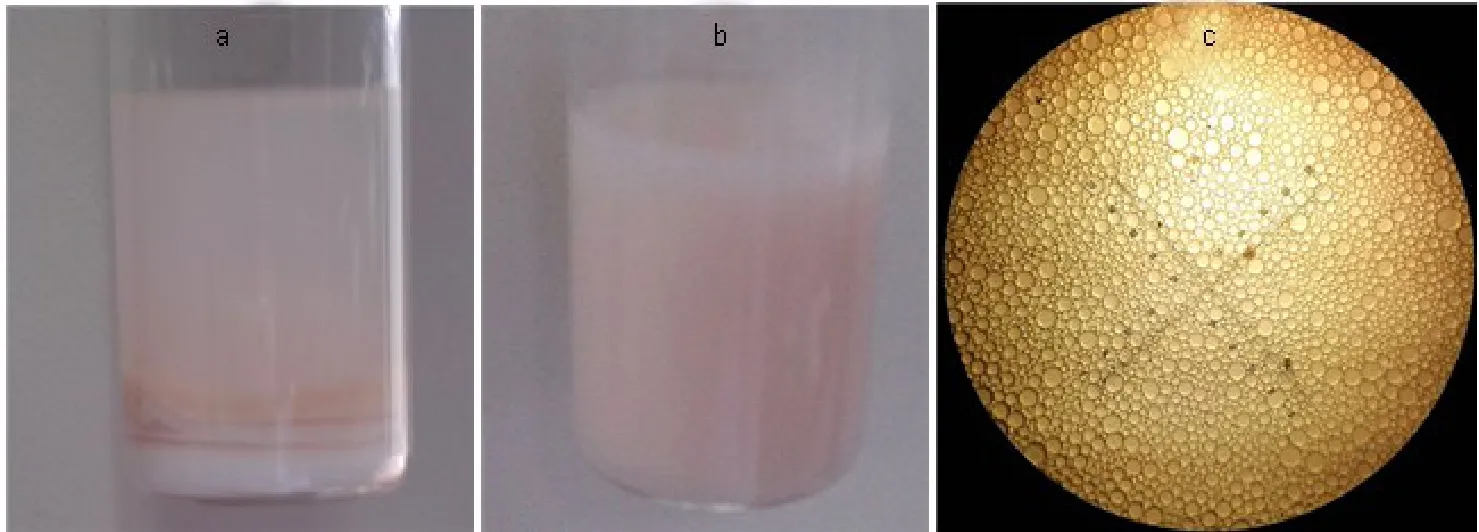
Fig.1 Digital photos of the Pickering HIPEs before(a)and after(b)rapid stirring,and optical microscope images of the resulting Pickering HIPEs(c)
Based on the dissolving of the water-dispersed monomer AM and crosslinker MBAM,the radical solution polymerization at 50°C for 24 h was initiated byAPS in the water phase.Atypical photograph of the MPFs 1 prepared from Pickering HIPEs was shown in Fig.3.As a result,macroporous polymers with no significant shrinkage were obtained after drying.Moreover,the resulting foam structure of MPFs 1 was seen to be irregular containing many large pores,which could be the result of emulsion destabilization during the polymerization process24.
3.2Characterization of MPFs
The main functional groups of the predicted structure of MPFs were further observed with corresponding infrared absorption peaks(Fig.4).All the FT-IR spectra show the similar characteristic signature for MPFs 1 and MPFs 2.As shown in Fig.4,the presence of bands at 1105 cm-1(stretching mode of apical Si―O),1021 cm-1(stretching vibrations of Si―O―Si)and 554 cm-1(deformation vibration of Al―O―Si),indicated that stabilized HNTs were indeed located in the MPFs25.The appearance of absorption bands at 3427,3201,1667,and 1454 cm-1assigned to free―NH2, associated―NH2,―C=O,and deformation vibration of―CH2―, respectively,also demonstrate evidence for the action ofAM26.
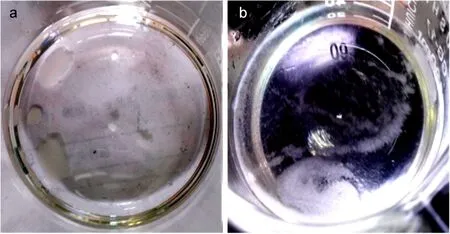
Fig.2 Digital photographs of a drop of Pickering HIPEs dispersing in toluene(a)and water(b)
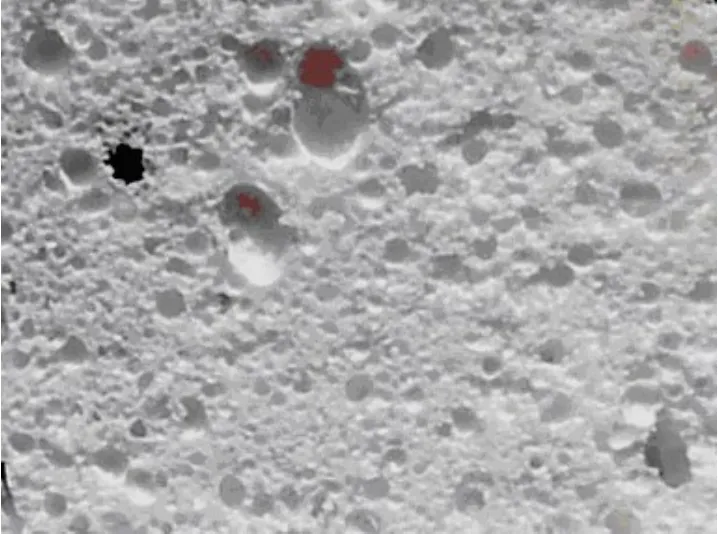
Fig.3 Digital photograph of MPFs 1

Fig.4 FT-IR spectra of MPFs 1 and MPFs 2
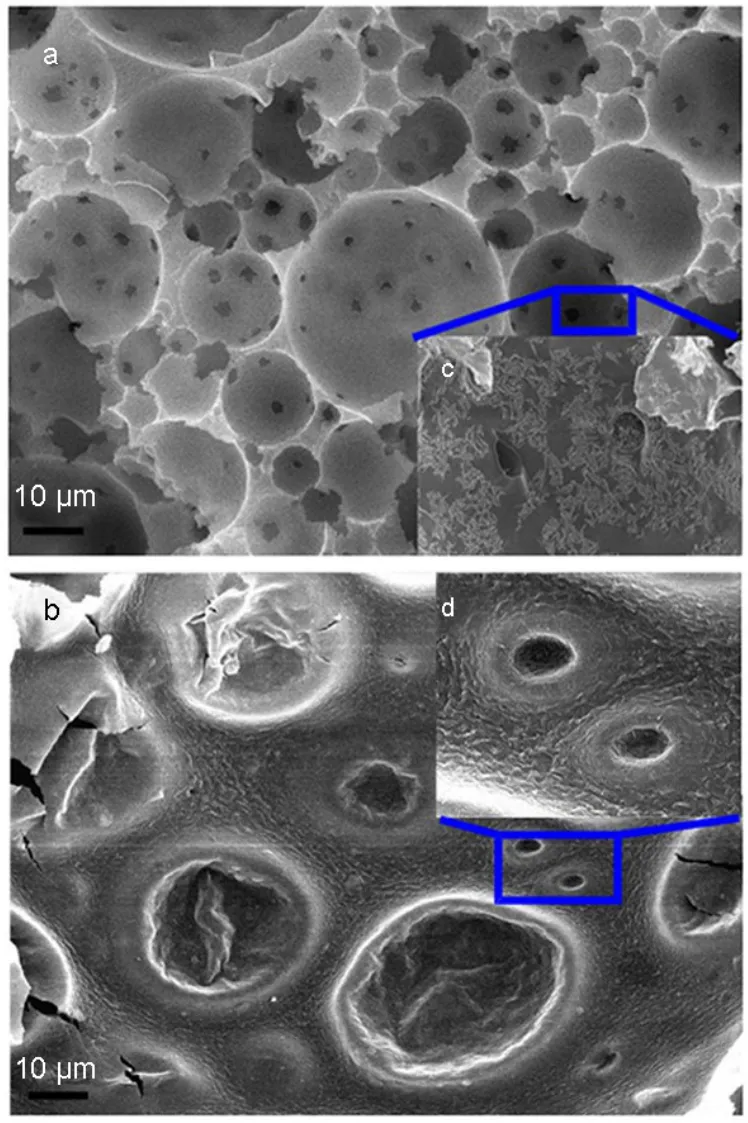
Fig.5 SEM images of MPFs 1(a),MPFs 2(b)and enlarged images of external surfaces of the MPFs 1(c),MPFs 2(d)
The SEM images of MPFs 1(a),MPFs 2(b)and enlarged images of external surfaces of the MPFs 1(c),MPFs 2(d)were shown in Fig.5,which displayed their monolithic morphology.As shown in Fig.5a,MPFs 1 possess an open cell structure with interconnected pores,with the void size and pore size are 5.0 to 35 μm and 1.0 to 3.0 μm,respectively.The possible formation mechanism of porous structure is that films separating the emulsion droplets are thin in the presence of surfactant Tween 85, which provides the more chance to break droplets in the emulsion templates and form pore throats.The large void size of the interconnected porous materials is a useful structure for many applications,such as adsorption process and scaffold for tissueengineering.With the absence of surfactant Tween 85,MPFs 2 possess a closed-cell structure,and a thin polymer film covered their void region,which make it difficult to be used in practical applications.The closed-cell structure of MPFs 2 may be due to the HNTs particles surrounding the oil droplets thickly that hindered the nearness of the adjacent HIPEs drops during curing process,which is not benefit for the drainage of the continuous phase liquid and formation of interconnected pores27.By comparison the enlarged image of external surface of the MPFs 1 (Fig.5c)with MPFs 2(Fig.5d),it could be observed that MPFs 2 had more rough external surface,strongly indicating that more stabilized HNTs are concentrated on the surfaces of void walls. Moreover,randomly distributed HNTs are deposited on the exterior surface of polymer shell rather than being embedded within it,indicating that the surface of the HNTs is sufficiently wettable by the dispersed oil phase without further modification.
Fig.6 shows the TGA(a)and DTG(b)curves of the MPFs 1 and MPFs 2.As shown in Fig.6a,MPFs 1 and MPFs 2 showed obvious weight loss at 50-150°C(about 10.44%and 13.06%for MPFs 1 and MPFs 2,recpectively),assigned to the desorption of water. This phenomenon indicates the slight adsorption content of water on MPFs 1 and MPFs 2,which might be due to their hydrophilic nature28.The pronounced weight loss(about 15.74%and 13.12% for MPFs 1 and MPFs 2,recpectively)in the temperature range of 220 to 310°C is caused by the thermal degradation of the crosslinker MBAM.Between the 310 to 500°C,about 56.47%and 57.04%of weight losses resulted fromAM polymers content were tested for MPFs 1 and MPFs 2,respectively.With the temperature increased to 800°C,the significant weight losses of MPFs 1 and MPFs 2 could be seen,and about 18.31%and 21.74%of the material remaining at 800°C for the MPFs 1 and MPFs 2 was stablized HNTs particles.The TGA curves of MIPFs and NIPFs have the same trend,indicating they possessed of similar morphological structure and size distribution29.The TGAanalysis also reveals that the prepared MPFs included both inorganic and organic composites30.In Fig.6b,the endothermic peaks for as-prepared MPFs(around 60.5,274.9,and 406.2°C)are also observed, which could be assigned to the desorption of water and decomposition of poly-MBAM,poly-AM,respectively.
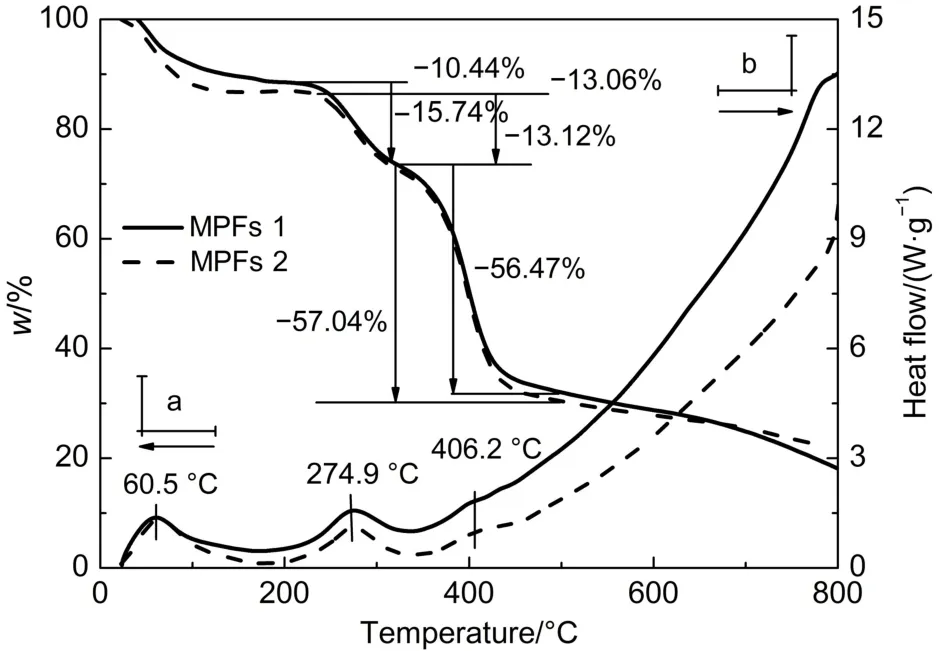
Fig.6 TGA(a)and DTG(b)curves of the MPFs 1 and MPFs 2
In order to know about the surface wettability of as-prepared MPFs,the static water contact angle of MPFs 1 was measured.As shown in Fig.7a,the water contact angle of MPFs 1 is only 18.97°, which is strongly hydrophilic.Moreover,photograph showing the water and suspended MPFs 1 is listed in Fig.7b.From the comparative photograph of the water and suspended MPFs 1,it could be concluded that MPFs 1 possess high dispersion stability in water.
3.3Kinetics study
The kinetic of adsorption for λ-cyhalothrin by MPFs adsorbent was evaluated at an initial λ-cyhalothrin concentration of 100 mg· L-1,adsorbent dosage of 1 g·L-1and a contact time of 720 min. The kinetics study is useful to predict the adsorption rate which is very important in modeling and designing of the adsorption process31.The pseudo-first and pseudo-second order kinetics models,as the most widely used models,were used to evaluate the mechanism of adsorption process.The pseudo-first-order equation can be expressed as linear and nonlinear forms by Eqs.(2)and(3), respectively.

The pseudo-second-order can be expressed as linear and nonlinear forms by Eqs.(4)and(5),respectively.

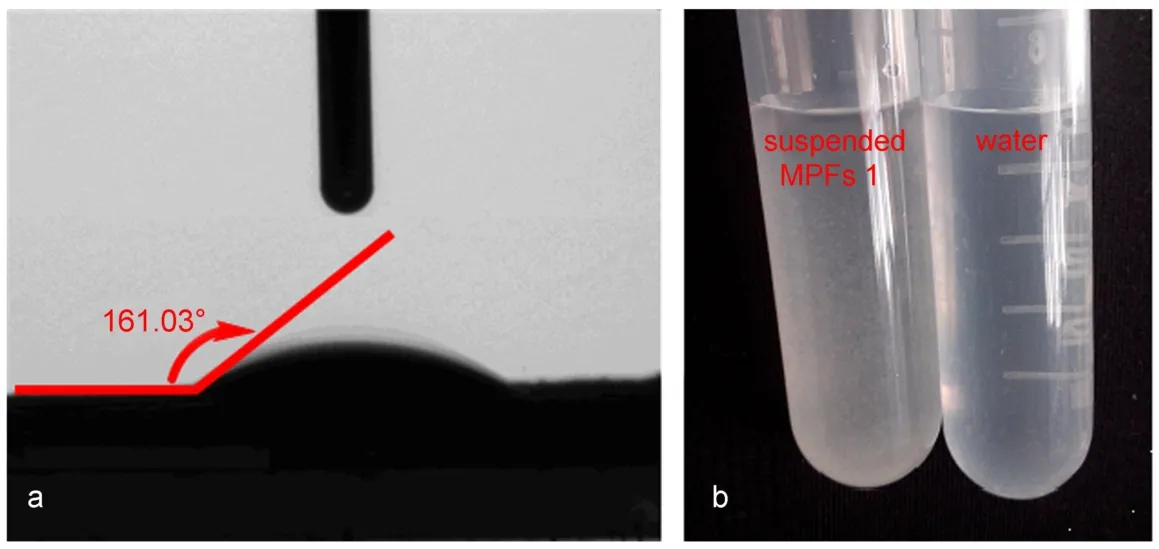
Fig.7 Profile of a water drop on film of the MPFs(a),and photograph showing the water and suspended MPFs 1(b)
where Qt(mg·L-1)and Qe(mg·L-1)are the amount of λ-cyha-lothrin adsorbed at time t and at equilibrium,respectively.k1(L· min-1)and k2(g·mg-1·min-1)are the rate constants of the pseudofirst and pseudo-second models,which can be calculated from the plots of ln(Qe-Qt)versus t and t/Qtversus t,respectively.

Table 1 Kinetic model parameters obtained in adsorption of λ-cyhalothrin onto MPFs 1 and MPFs 2
The kinetic parameters and correlation coefficients(R2)of the pseudo-first-order and pseudo-second-order models were shown in Table 1.Compared with the correlation coefficient of the pseudo-first-order model(R2=0.968),that of the pseudo-secondorder model(R2=0.992)is obviously higher for λ-cyhalothrin onto macroporous polymer foams,implicating that the pseudosecond-order model relatively fitted for the experimental kinetic data better.Simultaneously,the experimental Qe(Qe,exp)is more in agreement with the pseudo-second-order model.Generally,the kinetic of the adsorption process should fit to the pseudo-firstorder model if adsorption is controlled by diffusion through a boundary layer.However,the process of adsorption usually refers to various kinds of mechanisms such as chemical and electrostatic interactions between binding sites and adsorbate32.In Fig.8, considered that the kinetic process of the adsorption for λ-cyhalothrin fits to the pseudo-second-order model well,it is assumed that the determining race step may be chemisoption promoted by covalent forces through the electrons sharing between the adsorbent and adsorbate implying that the adsorption of λ-cyhalothrin on MPFs is mainly the chemical reactive adsorption33.
3.4Adsorption mechanism
Weber and Morris34had presented intraparticle diffusion model in 1962,since then intraparticle diffusion model has been applied in three different forms35,and one of them can be expressed as follows:

where C(mg·g-1)is the intercept and Kdifis the intraparticle diffusion rate constant(mg·g-1·min-1/2),the values of intercept C (Table 1)provide information about the thickness of the boundary layer,the resistance to the external mass transfer increases as the intercept increases.Theoretically,such type of plots may present a multi-linearity implying that two or more steps occur36,37.
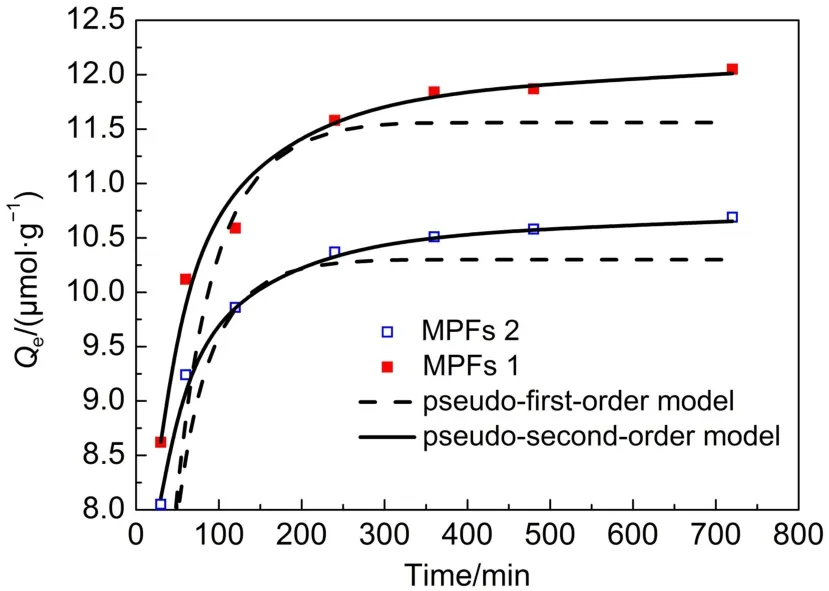
Fig.8 Kinetic data for adsorption of λ-cyhalothrin onto MPFs 1 and MPFs 2
The formation of hydrogen bonding between λ-cyhalothrin and amide group in the adsorbent may be the main function during the process of adsorption.Similar results are observed on the first stage of the intraparticle diffusion model(Fig.9).The first stage is the external surface sorption,which was driven by high initial λ-cyhalothrin concentration difference38.As can be seen in Fig.9, the first stage is rapidly completed within about 30 min,and the rate parameters in Table 1 show that the value of Kdifis extremely near which can be explained by the similar structure in the external surface.Furthermore,the second stage is the gradual sorption process where intrapaticle diffusion is rate-controlled.It is obvious that the slope of MPFs 1 sorption plot is greater than that of MPFs 2 plot implying a faster adsorption rate of MPFs 1(parameters of the stage are presented in Table 1),which is due to the open cell structure with interconnected pores of MPFs 1.Finally,the third stage is the equilibrium stage where intrapaticle diffusion starts to slow down due to the saturation of MPFs for λ-cyhalothrin.Simultaneously,the equilibrium adsorption capacity of MPFs 1 is greater than that of MPFs 2,which could also due to the interconnected pores.Through the interconnected pores,MPFs 1 provides more surface and binding sites than MPFs 2,resulted in the larger adsorption capacity of MPFs 1.Besides,the linear lines of the second and third stages do not pass through the origin, which shows that the intraparticle diffusion is not the only rate limiting mechanism in the adsorption process39.It may be concluded that surface adsorption and intrapaticle diffusion are concurrent operating during λ-cyhalothrin and MPFs interactions.
3.5Equilibrium study
Adsorption isotherms of MPFs 1 for λ-cyhalothrin at different temperature are shown in Fig.10.To evaluate the isotherm models, adsorbent dosage and contact time were set to 1 g·L-1and 12 h, respectively.The Langmuir,Freundlich adsorption isotherm models were used to describe the equilibrium between adsorbed λ-cyhalothrin and free λ-cyhalothrin in solution.The linear and nonlinear forms of the Langmuir isotherm model are as following equations,respectively.

where Qe(mg·L-1)and Ce(mg·L-1)are the equilibrium adsorption capacity and the equilibrium concentration of adsorbate at equilibrium,respectively.Simultaneously,Qm(µmol·g-1)and KL(L· mg-1)are the maximum adsorption capacity of the adsorbent and the affinity of the binding sites(Langmuir constant),severally40,41.
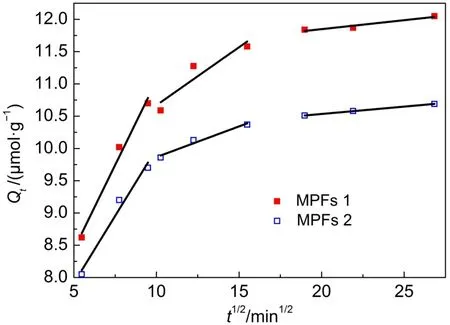
Fig.9 Intraparticle diffusion model plots for the adsorption of λ-cyhalothrin onto MPFs 1 and MPFs 2

Fig.10 Adsorption isotherms of MPFs 1 for λ-cyhalothrin at different temperatures and MPFs 2 at 298 K

Table 2 Adsorption of isotherm contants for λ-cyhalothrin
The linear and nonlinear forms of Freundlich isotherm are expressed by the following equations,respectively:

where KF(mg·L-1)is the Freundlich adsorption equilibrium constant,and 1/n is a measure of exchange intensity or surface heterogeneity,with a value of 1/n smaller than 1.0 describing favorable removal conditions42.
It is obvious that the amount of λ-cyhalothrin adsorbed increased with the increasing initial λ-cyhalothrin concentration, indicating that increasing the initial concentration of λ-cyhalothrin is beneficial to improve the adsorption capacity.This fact can be explained by the saturation of the adsorbent.The adsorbate,λcyhalothrin,can be adsorbed continuously until the saturation of the adsorbent is reached when the concentration is large enough. It is assumed that the saturation is related to the binding sites of the adsorbent.In other words,there are no more binding sites for λ-cyhalothrin to recognize while the adsorption is saturated.In addition,the maximum adsorption capacity of λ-cyhalothrin onto MPFs 1 increased from 23.98 to 26.50µmol·g-1with the temperature varying from 298 to 318 K,which could be investigated from Table 2.According to Table 2,obviously,the values of the correlation coefficients imply that the Langmuir model best fit λcyhalothrin adsorption onto MPFs 1(R2=0.995)and the maximum adsorption value calculated by Langmuir model was also very close to experimental capacity,demonstrating that the experiment data is described by the monolayer Langmuir adsorption isotherm more accurately than the Freundlich model at different temperatures41.Langmuir isotherm supposed that uptake of λcyhalothrin occurs at specific homogeneous adsorption sites by monolayer adsorption without any interaction between the adsorbed molecules43.As represented in Table 2,the maximum adsorption capacity of MPFs 1 for adsorption of λ-cyhalothrin was 23.98µmol·g-1at 298 K.Moreover,the obtained MPFs are effective to capture λ-cyhalothrin in a low concentration according to the tendency of Langmuir fit curve.The maximum adsorption capacity of MPFs 2 prepared in the study for adsorption of λcyhalothrin is 21.26 μmol·g-1,which could also be observed in Fig.10.
To predict the favorability of an adsorption system,the Langmuir equation can also be expressed in terms of a dimensionless separation factor(RL)which is defined as follows40:

where Cm(mg·L-1)is the maximal initial concentration of the adsorbate.The values of RLparameters arranged as RL=0,0<RL<1,and RL>1 propose that adsorption is irreversible,favorable and unfavorable,respectively44.The values of RLdisplayed in Table 2 show that RLis between 0.406 and 0.581 indicating that the adsorption of λ-cyhalothrin onto MPFs 1 would be favorable.
4 Conclusions
In this study,the O/W HIPE stabilized by the natural mineral NHTs nanoparticles was obtained,and the resultant macroporous polymer foams were synthesized.The adsorption of λ-cyhalothrin by MPFs was observed.The results show that the time of reaching equilibrium for λ-cyhalothrin onto MPFs 1 is approximately 240 min.According to isotherm models,the Langmuir isotherm fits well to the experimental data,implying that the process of the adsorption was a monolayer adsorption.In addition,the value of RLis between 0.406 and 0.581 indicating that the adsorption of λ-cyhalothrin onto MPFs 1 would be favorable.Simultaneously,the pseudo-second-order model is more suitable than pseudo-firstorder model for λ-cyhalothrin onto the adsorbent,suggesting that it is a chemical reactive adsorption.In a word,the novel hydrophilic macroporous polymer foams prepared through Pickering HIPE technology can be a potential and reliable adsorbent for the removal of the hydrophobic organic pollutants from the aqueous phase.
(1) Worrall,F.Environ.Sci.Technol.2001,35,2282.doi:10.1021/ es001593g
(2) Pan,J.M.;Qu,Q.;Cao,J.;Yan,D.;Liu,J.X.;Dai,X.H.;Yan, Y.S.Chem.Eng.J.2014,253,138.doi:10.1016/j. cej.2014.05.031
(3) Delgado-Moreno,L.;Wu,L.;Gan,J.Environ.Sci.Technol. 2010,44,8473.doi:10.1021/es102277h
(4) Hamadi,N.K.;Swaminathan,S.;Chen,X.D.J.Hazard.Mater. 2004,112,133.doi:10.1016/j.jhazmat.2004.04.011
(5) Al-Qodah,Z.;Shawaqfeh,A.T.;Lafi,W.K.Desalination 2007, 208,294.doi:10.1016/j.desal.2006.06.019
(6) Gupta,V.K.;Ali,I.Water Res.2001,35,33.doi:10.1016/ S0043-1354(00)00232-3
(7) Zhou,J.L.;Rowland,S.J.Water Res.1997,31,1708. doi:10.1016/S0043-1354(96)00323-5
(8) Xu,F.Q.;Zhang,N.N.;Long,Y.;Si,Y.M.;Liu,Y.;Mi,X.; Wang,X.D.;Xing,F.B.;You,X.D.;Gao,J.P.J.Hazard. Mater.2011,188,148.doi:10.1016/j.jhazmat.2011.01.094
(9) Chang,B.B.;Guan,D.X.;Tian,Y.L.;Yang,Z.C.;Dong,X.P. J.Hazard.Mater.2013,262,256.doi:10.1016/j. jhazmat.2013.08.054
(10) Zhu,Z.Q.;Zeng,H.H.;Zhu,Y.N.;Yang,F.;Zhu,H.X.;Qin, H.;Wei,W.H.Sep.Purif.Technol.2013,117,124.doi:10.1016/ j.seppur.2013.05.048
(11) Haibach,K.;Menner,A.;Powell,R.;Bismarck,A.Polymer 2006,47,4513.doi:10.1016/j.polymer.2006.03.114
(12) Vílchez,A.;Rodríguez-Abreu,C.;Esquena,J.;Menner,A.; Bismarck,A.Langmuir 2011,27,13342.doi:10.1021/ la2032576
(13) Manley,S.S.;Graeber,N.;Grof,Z.;Menner,A.;Hewitt,G.F.; Stepanek,F.;Bismarck,A.Soft Matter 2009,5,4780. doi:10.1039/B900426B
(14) Ikem,V.O.;Menner,A.;Bismarck,A.Langmuir 2010,26, 8836.doi:10.1021/la9046066
(15) Hermant,M.C.;Verhuls,M.;Kyrylyuk,A.V.;Klumperman,B.; Koning,C.E.Compos.Sci.Technol.2009,69,656. doi:10.1021/la9046066
(16) Ikem,V.O.;Menner,A.;Horozov,T.S.;Bismarck,A.Adv. Mater.2010,22,3588.doi:10.1002/adma.201000729
(17) Hua,Y.;Zhang,S.M.;Zhu,Y.;Chu,Y.Q.;Chen,J.D. J.Polym.Sci.Part A:Polym.Chem.2013,51,2181. doi:10.1002/adma.201000729
(18) Li,Z.;Wei,X.;Ngai,T.Chem.Commun.2011,47,331. doi:10.1039/C0CC02106G
(19) He,Q.;Yang,D.;Deng,X.L.;Wu,Q.;Li,R.;Zhai,Y.;Zhang, L.Water Res.2013,47,3976.doi:10.1039/C0CC02106G
(20) Lehle,H.;Noruzifar,E.;Oettel,M.Eur.Phys.J.E.2008,26, 151.doi:10.1140/epje/i2007-10314-1
(21) Li,H.B.;Li,Y.L.;Cheng,J.Chem.Mater.2010,22,2451. doi:10.1021/cm902856y
(22) Koch,D.A.;Clark,K.;Tessier,D.M.J.Agric.Food.Chem. 2013,61,2330.doi:10.1021/jf3048912
(23) Pan,J.M.;Yin,Y.J.;Gan,M.Y.;Meng,M.J.;Dai,X.H.;Wu, R.R.;Shi,W.D.;Yan,Y.S.Chem.Eng.J.2015,266,299. doi:10.1016/j.cej.2014.11.126
(24) Oh,B.H.L.;Bismarck,A.;Chan-Park,M.B. Biomacromolecules 2014,15,1777.doi:10.1021/bm500172u
(25) Pan,J.M.;Zhu,W.J.;Dai,X.H.;Yan,X.S.;Gan,M.Y.;Li,L. Z.;Hang,H.;Yan,Y.S.RSC Adv.2014,4,4435.doi:10.1039/ C3RA43178A
(26) Liang,X.F.;Wang,H.J.;Tian,H.;Luo,H.;Chang,J.Acta Phys.-Chim.Sin.2008,24,223.[梁晓飞,王汉杰,田 惠,罗浩,常 津.物理化学学报,2008,24,223.]doi:10.1016/ S1872-1508(08)60011-X
(27) Menner,A.;Biamarck,A.Macromol.Symp.2006,242,19. doi:10.1002/masy.200651004
(28) Pan,J.M.;Zeng,J.;Cao,Q.;Gao,H.P.;Gen,Y.C.;Peng,Y. X.;Dai,X.H.;Yan,Y.S.Chem.Eng.J.2016,284,1361. doi:10.1016/j.cej.2015.09.023
(29) Zhang,Y.;Liu,R.J.;Hu,Y.L.;Li,G.K.Anal.Chem.2009,81, 967.doi:10.1021/ac8018262
(30) Chen,H.Q.;Wang,W.;Li,G.L.;Li,C.;Zhang,Y.Synth.Met. 2011,161,1921.doi:10.1016/j.synthmet.2011.06.036
(31) Khorramabadi,G.S.;Soltani,R.D.C.;Rezaee,A.;Khataee,A. R;Jafari,A.J.Can.J.Chem.Eng.2012,90,1539.doi:10.1002/ cjce.20661
(32) Soltani,R.D.C.;Khorramabadi,G.S.;Khataee,A.R.;Jorfi,S. J.Taiwan.Inst.Chem.Eng.2014,45,973.doi:10.1016/j. jtice.2013.09.014
(33) Sun,Y.B.;Yang,S.B.;Zhao,G.X.;Wang,Q.;Wang,X.K. Chem.Asian J.2013,8,2755.doi:10.1002/asia.201300496
(34) Weber,W.;Morris,J.J.Sanit.Eng.Div.Am.Soc.Civ.Eng. 1963,89,31.
(35) Wu,F.C.;Tseng,R.L.;Juang,R.S.Chem.Eng.J.2009,153, 1.doi:10.1016/j.cej.2009.04.042
(36) Hameed,B.H.;Tan,I.A.W.;Ahmad,A.L.Chem.Eng.J.2008, 144,235.doi:10.1016/j.cej.2008.01.028
(37) Juang,R.S.;Wu,F.C.;Tseng,R.L.J.Colloid Interface Sci. 2000,227,437.doi:10.1006/jcis.2000.6912
(38) Zhou,J.B.;Wang,L.;Zhang,Z.;Yu,J.G.J.Colloid Interface Sci.2013,394,509.doi:10.1016/j.jcis.2012.11.050
(39) Xue,G.H.;Gao,M.L.;Gu,Z.;Luo,Z.X.;Hu,Z.C.Chem.Eng.J.2013,218,223.doi:10.1016/j.cej.2012.12.045
(40) Allen,S.J.;Mckay,G.;Porter,J.F.J.Colloid Interface Sci. 2004,280,322.doi:10.1016/j.jcis.2004.08.078
(41) Wang,Y.;Qi,Y.X.;Li,Y.F.;Wu,J.J.;Ma,X.J.;Yu,C.;Ji,L. J.Hazard.Mater.2013,260,9.doi:10.1016/j. jhazmat.2013.05.001
(42) Garbassi,F.;Balducci,L.;Chiurlo,P.;Deiana,L.Appl.Surf.Sci. 1995,84,145.doi:10.1016/0169-4332(94)00469-2
(43) Heidari,A.;Younesi,H.;Mehraban,Z.Chem.Eng.J.2009, 153,70.doi:10.1016/j.cej.2009.06.016
(44) Rahmani,A.;Mousav,H.Z.;Fazli,M.Desalination 2010,253, 94.doi:10.1016/j.desal.2009.11.027
Adsorption of λ-Cyhalothrin onto Macroporous Polymer Foams Derived from Pickering High Internal Phase Emulsions Stabilized by Halloysite Nanotube Nanoparticles
CHEN Xiang PAN Jian-Ming*YAN Yong-Sheng
(School of Chemistry and Chemical Engineering,Jiangsu University,Zhenjiang 212013,Jiangsu Province,P.R.China)
Macroporous polymer foams(MPFs)were prepared through oil-in-water(O/W)Pickering high internal phase emulsions(HIPEs)stabilized by the natural clay halloysite nanotube(HNT)nanoparticles with the addition of small amounts of the nonionic surfactant Tween 85.The resulting MPFs were characterized,and the results showed an open cell structure with interconnected pores and a hydrophilic surface with a suspended state in aqueous solution.These features were beneficial for the adsorption of pyrethroids.Moreover,the adsorption of λ-cyhalothrin on MPFs was examined to determine the kinetic and equilibrium data of the adsorption process.The findings of the kinetic and equilibrium studies revealed that a pseudo-second-order kinetic model and the Langmuir isotherm were the best fitted models(R2>0.99),implying that the process of adsorption is a monolayer and chemically reactive.In addition,the maximum adsorption capacity and equilibrium time for λ-cyhalothrin on MPFs were estimated to be 23.98 μmol·g-1and 240 min at 298 K.Increasing the temperature led to an increase in adsorption capacity.Increasing the initial concentration of λ-cyhalothrin led to an increase in clear adsorption capacity.Finally,the suspended MPFs represent a promising and reliable adsorbent for the removal of hydrophobic organic pollutants from aqueous solutions.
O647
10.3866/PKU.WHXB201609073
Received:August 2,2016;Revised:September 7,2016;Published online:September 7,2016.
*Corresponding author.Email:pjm@ujs.edu.cn;Tel:+86-511-88791708.
The project was supported by the National Natural Science Foundation of China(21574091,21576120)and National Postdoctoral Science Foundation,China(2013M540423).
国家自然科学基金(21574091,21576120)和国家博士后基金(2013M540423)资助项目

